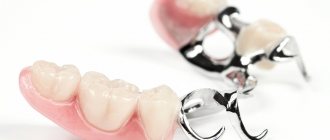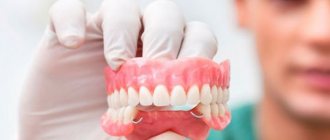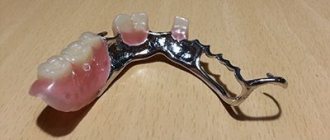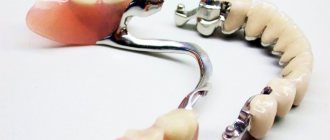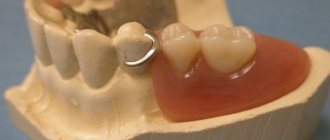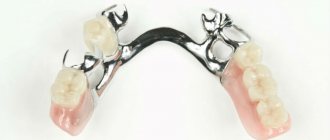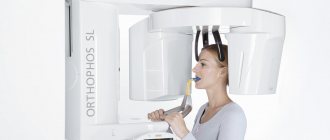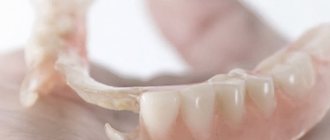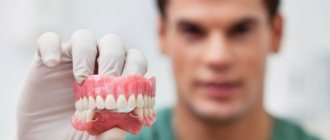Classification of attachments for correcting malocclusion (especially difficult cases) through the use of transparent aligners.
Part 3
- Mouthguard for correcting malocclusion in adults - aligners.
- How to correct crooked teeth, using attachments
- When there is no need for attachments - exposure of the root, pronounced equator of the tooth crown, the presence of bridges, the presence of implants
- Aligners, attachments, their types
- Samara. 8-846-990-88-56
Attachments serve to emphasize fulcrum points and areas of application of force, optimize the moment of force, reduce treatment time and the number of aligners used, and most importantly, obtain a predictable treatment result. (see part 1 and part 2)
Different manufacturers have their own terminology and application descriptions.
What is a prosthesis with attachments?
Attachment (from the English attachment “attachment”) is a locking or hinged fastening that allows parts of one structure to be securely fixed together, i.e. prosthesis. In essence, it is a micro-lock that provides a strong and reliable connection between the supporting teeth and the prosthesis.
On a note! Sometimes attachments are called attachments, that is, they skip the letter “t” at the end of the word. But based on the English sound, the first name is still correct.
The attachment itself consists of two parts - a patrix and a matrix. The patrix is most often located in the supporting crown (less often - in the prosthesis itself). It can be made in the form of a ball or cylinder, cube or rack. The matrix is the second part of the micro-lock, which is located mainly in the prosthesis (less often in the root). It is hollow, made in the form of a recess, and is placed under the artificial gum inside the prosthesis. When fixing the device, the male enters the matrix, and they snap into place.
Materials for the manufacture of matrices and patrixes are plastic or metal. Often the patrix is made of metal, and the matrix is made of plastic.
What types of structures can be fixed with attachments?
Such a fastening element can be provided in clasp dentures, as well as in any partial removable devices (intended to restore part of the teeth in the mouth), made of nylon, acrylic, and monomer-free plastics. For fixation on attachments, it is necessary that the abutment teeth or at least their roots (at least two pieces) are preserved in the patient’s mouth, on which artificial inlays or crowns with one of the fastening elements - the male can be installed. If there are no “supports” in the mouth, then this type of structure cannot be installed.
Such products are also called conditionally removable, because the patient does not need to remove them from the mouth on a permanent basis, like completely removable devices.
Prostheses with attachments - features and advantages of designs with locking fastenings
Attachments in dentistry are a separate type of fastenings in removable and partially removable prosthetic devices. Essentially, this is a locking mechanism that includes two main elements: the first is fixed on the abutment tooth, stump inlay or crown, and the second on the orthopedic structure. At the moment of fixation, the parts are connected and snapped together, ensuring reliable fastening of the device in the mouth. According to many patients, dentures with this type of fastening are more comfortable to wear, cause less discomfort and fit securely in the mouth. Later in this material we will take a closer look at what it is, what pros and cons are typical for this type of prosthetics.
Classification of attachments by functional features
Clinical situations in which prosthetics are indicated are individual, therefore in dentistry there are several types of designs that differ in their functional features.
By location
- intracoronal: the patrix does not protrude beyond the hard tissues of the supporting tooth,
- extracoronal: when part of the attachment is glued or soldered over the crown. This type of fastening is rarely used, because Dentures installed in this way make oral hygiene difficult; bacterial plaque is deposited on the fastening elements, which is difficult to remove without the use of floss and irrigator. Yes, and they hold up worse,
- root: the patrix is located on the root,
- intraradicular: the patrix is located on the base of the prosthesis and is placed in the root.
By load distribution
Experts distinguish between movable and rigid locking structures. In hard ones, the matrix and patrix are motionless relative to each other, and then the load falls entirely on the supporting teeth. In mobile or labile teeth, the matrix and patrix are connected in such a way that the natural mobility between the parts is preserved, which allows the load to be distributed between the “bearing” teeth and the mucosa.
By type of connection
Locking structures attach the matrix to the patrix in different ways. For example, the friction method (using friction) is used in all designs with grooves, but the mechanical method is used in designs with a ball-shaped (push-button) lock. There is also a magnetic method, when parts of the product are attracted to each other by a magnet, and a screw method, when one part is connected to another using a screw thread. In addition, there are combined connection methods, most often mechanical-friction.
By production
Today there are two types of attachments. The first is standard or template (precision), manufactured in a factory - it is subsequently connected to the prosthesis by welding. The second option is a fastening system created in laboratory conditions (semi-precision) using special modeling casts. That is, for a specific patient.
On a note! The best manufacturers of locking attachments, according to professional orthopedic dentists: concern Rhein-83 (Italy), Bredent1 (Germany), Alvadent (Russia), CENDRES & METAUX SA DENTAL (Switzerland), Degussa (Germany).
Attachments can also differ in size - macro and micro.
What is special about attachments?
Currently, in dentistry there are several types of locks for installing orthopedic devices. However, the essence of the work of the fastening system comes down to one thing - fixation is ensured by snapping two independent elements together - one on the prosthesis, the other on the supporting tooth.
We can immediately classify them according to the method of manufacturing the mechanism. Thus, a distinction is made between precision and semi-precision attachments. In the first case, the system is created in a factory, and the elements are attached to the prosthesis by welding. The latter are created in a dental laboratory. Specialists model and cast parts based on previously taken impressions of the patient’s jaws1.
Types of fastenings
To attach the removable part to the static one (that is, the prosthesis itself to living teeth), you need to make a mount. Depending on which jaw the patrix will be on, what load it will take on, and also based on individual characteristics, designs with different types of attachments can be offered:
- spherical: this is the most common type of fastening, reminiscent of a button on clothing. On the static surface (holding tooth) there is a groove into which a device with a ball-shaped tip fits. In some cases, the opposite happens - it all depends on the clinical situation,
- rod (beam): this is the second most popular type, allowing prosthetics to be performed in cases of large tooth loss. The essence of the method is that crowns are put on the supporting teeth, to which a bar (beam) is welded. It extends over the entire toothless part of the gum. A counter rod (matrix) is made on the removable surface, which accurately follows the curves of the male and fits precisely into the grooves on it. Such systems provide a strong hold during chewing and at the same time firmly hold the supporting units,
- rail: on the matrix there is a T-shaped process, which fits into a T-shaped groove on the male.
Types used in dentistry
Main types of attachments:
- anchor or spherical (have a spherical patrix);
- block or rod (the design has a rod and a groove into which it is inserted);
- intracoronal or intradental (not visible from the outside, as they are hidden in the crown of the tooth);
- root pins (fixed in the tooth root);
- extracoronal or extradental (differ in mobility);
- crossbars (have a special feature - a special valve);
- rail (distinguished by the T-shaped patrix, which increases the friction force).
According to the degree of adjustment, attachments can be activated friction, non-adjustable, combined (hinge locks), spark-erosion (rotary) or push-button. According to the manufacturing method - accurate or semi-precise.
Indications for prosthetics with locks
General indications are partial absence of teeth, impossibility of installing implants due to health reasons or due to the financial capabilities of the patient. The products are also used when it is impossible to secure removable dentures, for example, when the patient has abnormalities in the structure of the palate.
On a note! The production of locking attachments is used in the absence of chewing teeth on both one and two sides. Designs based on spherical attachments are also used to restore single defects.
However, it is important to understand that each type of prosthesis with attachments has its own series of indications and contraindications. For example, a rod design in clasp prosthetics with attachments is indicated for periodontal diseases, because it allows you to immobilize (fix) abutment teeth and distribute the chewing load between healthy and diseased teeth. At the same time, the rod lock is not used in case of partial destruction of the supporting units.
Contraindications for prosthetics
General contraindications are the absence of supporting teeth or roots (minimum 2 pieces), into which it is impossible to install a patrix.
The presence of cardiovascular, endocrine and other severe chronic diseases prevents the installation of dentures if tooth preparation is required.
Pathological abrasion of enamel is also a contraindication for the installation of locking systems.
In case of irreversible periodontal pathologies (periodontitis and periodontal disease in the generalized stage), causing mobility of supporting teeth, prosthetics with attachments cannot be considered, because The reliability of fastening the devices in this case leaves much to be desired.
What determines the choice of fastening?
The choice of type of fastening depends on the situation in the oral cavity: what condition the natural teeth are in, whether there is a history of gum and periodontal diseases, whether there are other orthopedic products (bridges, crowns), how many consecutive teeth are missing in a row, etc.
In the absence of one or two teeth in a row, products with attachments are most often used (especially if for some reason it is impossible to carry out implantation). Here the orthopedic surgeon will choose between single crowns with a ball-shaped attachment and a barbell attachment.
When prosthetizing molars, especially if they are missing on both sides, the orthopedist will most likely choose a clasp system with push-button fastening, and if there are no chewing units on only one side, then the fastening will most likely be rail-based.
There are situations when a patient’s crown is destroyed, but the roots are preserved. In this case, the structure will be attached in a push-button manner.
Advantages of lock fastenings
- high smile aesthetics: the fastening elements are located inside the prosthesis, therefore, others will not even notice that you are wearing “artificial teeth”,
- reliable fixation of the device in the mouth: there is no need to worry about the prosthesis falling out of the mouth at the most inopportune moment,
- reducing the chewing load on the gums and mucous membranes,
- uniform distribution of chewing load,
- a quick period of adaptation and habituation,
- better protection of bone tissue from atrophy compared to completely removable systems,
- taste sensations and diction are not impaired: thanks to this type of fastening, it is possible to make the structure lighter and more compact, which is especially important for people who restore teeth in the upper jaw - it does not contain a massive palatal bridge, which causes discomfort and blocks the palatal receptors and salivary glands,
- When worn out, the locks can be replaced with new ones,
- there is no need to remove the denture from the mouth,
- devices on attachments do not require complex hygienic care.
Manufacturing of dentures with locking fastening
Before starting to make dentures, the doctor performs dental treatment and prescribes home treatment for gums. When the condition of the oral cavity is in perfect order, the specialist performs a lot of clinical and laboratory tests. After making prostheses with locking fastening, the doctor installs them for the patient, but does not fix them. This procedure allows you to obtain accurate impressions of teeth and gums, which will subsequently ensure the manufacture of comfortable fixed dentures. After such fitting, prostheses are made that correspond to the impressions obtained. The finished dentures are securely installed in the patient’s mouth.
In modern dentistry, tooth roots are often used in prosthetics. This procedure is called intraradicular prosthetics, in which fastening locks are installed directly into the roots. This method allows you to significantly increase the functional capabilities of the prosthesis and evenly distribute the chewing load throughout the entire oral cavity. Intraradicular prosthetics looks aesthetically pleasing and, due to its characteristics, increases the service life of the structure.
Installed dentures with locking fastenings do not create discomfort in the oral cavity, return a person to a beautiful smile and allow him to feel the joy of eating.
Disadvantages of lock systems
- high cost of the product,
- high requirements for the technical part of manufacturing: the presence of a high-precision cutter, an apparatus for casting molds and frames, the presence of a highly professional technician trained in the specifics of manufacturing structures using attachments,
- limited list of indications for installation: structures cannot be installed with complete edentia,
- the need for preparation of supporting units,
- fragility of lock fastenings: after 2-5 years they wear out, break and need to be replaced,
- load on living teeth: in general, the service life of such devices directly depends on the condition of the “supports”, and since Since they bear a large share of the load, they quickly collapse. The load on the “supports” is especially strong if the patient is missing a large number of teeth.
Indications for installing devices on locking mounts
In dental practice, there are situations when it is simply impossible to do without a locking type of fastening on a prosthesis. Here are the main indications for installing the structure on attachments:
- excessive demands on aesthetics if the patient’s work involves public speaking and constant communication with people,
- loss of all molars on one or both sides,
- almost complete edentia, in which the remaining teeth cannot provide stabilization of the structure during chewing,
- curvature of individual teeth, preventing the free removal and fixation of the prosthesis,
- noticeable shrinkage of the alveolar ridge,
- flat sky,
- malocclusion,
- abrasion of enamel and reduction in crown height,
- periodontal tissue diseases,
- diabetes.
Loss of all molars on one side is an indication for use.
Also, such systems are recommended in cases where the patient has certain pathologies of the heart and blood, which are accompanied by periodic bleeding of the gums. A denture with attachments may be the best choice for a patient suffering from bruxism - unconscious grinding of teeth at night.
The process of installing locking devices
Before installing the structure, it is important to sanitize the oral cavity, cure caries, check the condition of the gums, get rid of all sources of inflammation, and carry out professional cleaning. This is the first stage of installing the prosthesis.
At the second stage, when the oral cavity is sanitized, it is important to prepare the supporting units. The doctor necessarily removes the nerve, cleans the root canals, performs a filling and creates a depression.
At the third stage, the doctor makes impressions of the jaws, which are subsequently sent to the laboratory so that the technician can make a structure that meets the individual anatomical characteristics of the patient.
Next comes fitting and fitting of the product. When all the shortcomings have been eliminated, the doctor installs the structure in its intended place and gives the patient recommendations for wearing the prosthesis, teaches how to remove and put it on (although in general there should not be a need to perform these manipulations often).
Maintenance of lock systems
It is easier to care for a prosthesis with locks than for removable structures, but it also requires some skill and discipline.
Firstly, it is important to pay great attention to oral hygiene, because microbes will accumulate at the site of the patrix and matrix couplings. That is why doctors advise using additional oral care products - floss, irrigators, special brushes.
Secondly, dentures need to be removed and processed manually from time to time, and rinsed with special antiseptic solutions. Doctors recommend doing this before going to bed, although at first, while adaptation to the product occurs, it is better not to take it off at night.
Thirdly, the locking part of the structure is its weakest point, which means that after long-term use, defects may occur in it: chips, scratches, deformations. Therefore, it is important to be examined by an orthopedist at least twice a year so that he can identify defects in time and replace the matrix. To protect the fastening elements from premature wear and damage, you need to be careful when consuming solid foods and not putting excessive chewing load on the prosthesis.
It is also important to pay attention to the supporting teeth and mucous membranes, because... The service life of the devices will depend on their condition. If the “supports” are damaged, then the structures will have nothing to support them.
Advantages of designs on attachments
According to numerous patient reviews, models with attachments are much more convenient in many aspects. Here are the main advantages of such a fastening system:
- the ability to achieve impeccable aesthetics, since such fastenings are practically invisible on the teeth,
- high level of comfort - dentures are easy to take off and put on, allow you to maintain the proper level of hygiene, since they are easy to clean,
- in the event of a breakdown, you can easily replace the damaged element without the need to correct the entire device,
- guarantee increased strength and stability of the structure,
- provide a relatively uniform distribution of the chewing load.
These prostheses guarantee increased strength and stability of the structure.
“By the way, I just recently made myself a prosthesis with locks. Much more convenient than on hooks - this is my personal opinion. Firstly, the attachments are not visible at all, the smile looks natural and natural, nothing catches the eye. Secondly, getting used to it was much easier and faster, now I don’t experience any discomfort. Of course, I would like to undergo full-fledged implantation, but it costs money. So as a temporary solution, this is the best option.”
Yulia Sergeevna K., Krasnodar, from correspondence on the forum www.32top.ru
Despite the abundance of unconditional advantages, this fixation system also has its disadvantages. More details about them in the next section.
